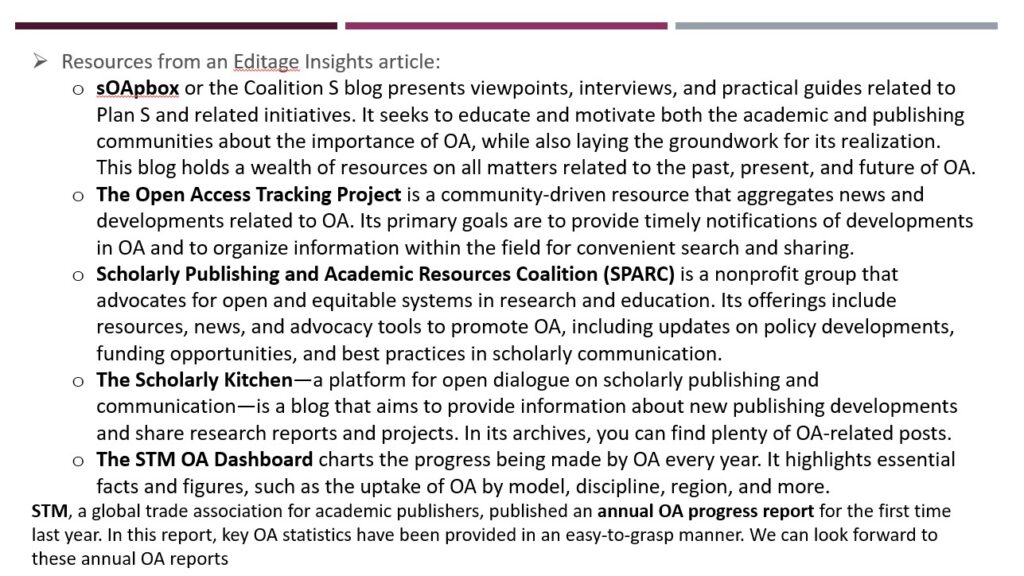MODERATOR:
Audra Jenson
J&J Editorial
SPEAKERS:
Justin Byrne
American Academy of Allergy, Asthma, and Immunology
Carolyn de Court
J&J Editorial
@CarolynMariePTL
Kathryn A Phillips
Health Affairs Scholar – Global and Emerging Health Policies
@KathrynP_phd
REPORTER:
Erin Landis
Origin Editorial
The CSE 2024 Annual Meeting session, “Starting a New Open Access Journal: Perspectives from the Front Lines,” featured a Q&A format that helped shed light on the myriad considerations for launching an open access (OA) journal. The session featured peer review management professionals and an editor-in-chief, which provided a well-rounded set of perspectives on the topic. Following is an overview of the questions that moderator Audra Jensen posed to the speakers, as well as a summary of their responses.
Why start an OA journal?
The panelists noted that there are a variety of reasons to start an OA journal, including wanting to keep good research “in the family,” instead of it being published elsewhere, to keep pace with the ever-accelerating shift toward an OA landscape in scholarly publishing, compliance with funder mandates, and providing authors with more choices for where and under what model to publish their research.
What pain points have you encountered?
Starting a new journal, let alone an OA journal, can present challenges, not the least of which, as the panelists noted, is convincing a society’s leadership that a new OA journal is necessary. Other challenges expressed by the panelists included attracting de novo submissions to the new OA journal (vs. having submissions cascade from the “parent” or “sister” journal), finding willing reviewers, navigating the indexing process, and the sheer amount of time and resources it takes for a successful launch.
Can You Please Discuss your journal’s relationship with sibling journals and with the publisher.
The panelists emphasized the need for a collegial and collaborative relationship among sibling journals, especially among the editors-in-chief and editorial boards. It is common for sibling journals to view each other competitively and for there to be concern that a new journal will cannibalize the submissions of the existing journals. To mitigate concerns over competition and foster a collaborative environment, the panelists offered several suggestions from their own portfolios, including hosting regular meetings among sibling journals (for both editorial boards and staff), having a clear understanding of the cascade relationship among the journals, and setting clear expectations for each journal in terms of its position and scope relative to the other journals in the family.
For the panelists whose journal programs have a publishing partner, they noted that the publisher was instrumental in all aspects of launching the new OA journal, including providing market research, guidance on scope, assistance with author recruitment, and comprehensive support with the indexing process.
What did you not know then that now you wish you had known, and what would you have done differently?
Carolyn De Court, J&J Editorial, emphasized the need to promote the new journal well in advance of the journal going live to build awareness and excitement—this strategy will help attract submissions for when the journal is ready to accept them. Justin Byrne, American Academy of Allergy, Asthma, and Immunology, advised that programs should build-in more time than they think they need when launching a new OA journal to account for unforeseen tasks and challenges. Other observations included reassuring authors that their articles will eventually appear in PubMed, and that indexing expertise is critical to building successful applications.
Where is OA going next and what are the key steps for moving forward?
The panelists agreed that OA will continue to evolve and become more firmly ingrained in scholarly publishing, with Kathryn Phillips, Health Affairs Scholar – Global and Emerging Health Policies, noting that we need more evidence of its impact on research and its outputs. They also emphasized that all stakeholders in the scholarly publishing ecosystem need to be more informed and educated about OA, including authors. To help stay abreast of developments in OA, De Court shared a list of helpful resources (Figure). Byrne also suggested that a journal’s publisher is also a good source of information about OA.

The participants in the session were very engaged and had a number of questions for the panelists themselves, which are summarized below.
How did you develop a unique identity for your new OA journal?
Advice for this question included using social media to develop a “personality” for the journal, conducting market research and gap analyses to understand where the new journal can “fit” in the landscape, and marketing the unique aspects of the journal that are not content-focused but rather, focus on other characteristics such as fast peer review, global focus, author engagement, etc.
What process did your society follow to seek approval for the new OA journal?
The panelists explained that they needed to acclimatize their leadership to the idea of a new OA journal, providing the rationale and value for launching one. They leaned heavily on the support of their publishers to present such justification to their governance boards.
What are the success metrics for your OA journal?
The panelists’ answers to this question, based on the goals they had set for their new OA journals, included attracting and publishing a certain number of papers within the first year, hitting revenue targets, achieving a predetermined rejection rate, and time-to-decision.
In summary, the panelists provided very practical insight and advice to anyone whose organization is looking to launch a new OA journal.
